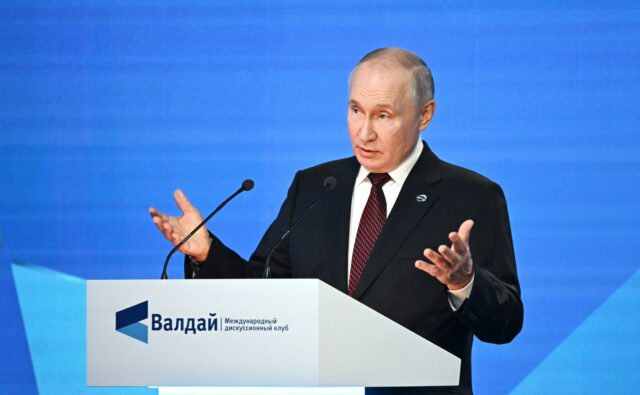
Russia Moves to Cancel Ratification of Comprehensive Nuclear Test-Ban Treaty
Publication: Eurasia Daily Monitor Volume: 20 Issue: 158
By:

On October 6, Russia voiced its intentions to cancel ratification of the Comprehensive Nuclear-Test-Ban Treaty (CTBT), which Moscow signed in 1996 and officially ratified in 2000. Russian President Vladimir Putin delegated responsibility for this move to the Russian State Duma, and the legislative body and the Russian Foreign Ministry began executing his order (Kremlin.ru, October 5; Duma.gov.ru, October 9; Kommersant, October 10). Earlier, some Russian propagandists and more hawkish experts claimed that such a move would demonstrate Moscow’s readiness to develop more nuclear weapons and carry out nuclear tests with an aim “to bring the fear of nuclear” warfare back (Globalaffairs.ru, September 26, 2022, June 13, June 20, June 21; Ngs.ru, October 4).
The Kremlin’s official explanation for withdrawing from the CTBT is to achieve parity with the United States in its nuclear capabilities. The United States signed the CTBT in 1996 but has yet to ratify it. Behind closed doors, though, it seems that Moscow is most concerned with the failure to reach its desired diplomatic goals with the past several rounds of nuclear blackmailing in recent years. This approach has included holding more strategic nuclear exercises and suspending the Strategic Arms Reduction Treaty (START). With Russia’s ongoing war against Ukraine, Washington and its allies are not in a position to negotiate with the Kremlin in the traditional arms control format. However, Moscow’s planned cancellation of CTBT ratification does not mean the cancellation of Russia’s status as a signatory to the treaty. Thus, Russia will not automatically be allowed to conduct nuclear tests. The possible resumption of nuclear tests in the near future has more to do with Russia choosing to consistently violate the nuclear non-proliferation regime and cooperating with other violators such as Iran and North Korea.
Amid this process, Moscow is monitoring the global political reaction. If the Kremlin’s general response is deemed disappointing, full withdrawal from the CTBT is highly unlikely. Russia may further justify such steps based on the technical necessity for maintaining the long-term safety of nuclear warheads. However, according to Moscow, Russia’s nuclear arsenal remains functional and requires no testing. Most of the components used in Russian warheads can be tested during subcritical tests, and Russia still possesses the necessary supercomputer capabilities to simulate processes within modernized warheads through live testing (Kommersant, October 10). All this means that the issue of nuclear tests is only part of Russia’s recent escalatory steps.
Despite Moscow’s intentions, one mechanism may serve to prevent Russia from completely withdrawing from the CTBT. Russia will likely continue to be limited by the global network of hundreds of monitoring stations integrated into the Commission for the Comprehensive Nuclear-Test-Ban Treaty Organization Preparatory Commission. Russia’s segment of the network includes 32 stations. In the case of a full withdrawal from the CTBT, the Kremlin will be limited in its ability to monitor other nuclear tests worldwide. It is unclear whether Moscow is ready to sacrifice participation in this activity, though this obstacle should not be overestimated. Russia will still be able to monitor nuclear activity in North Korea, Iran, South Asia, and Central Asia with its own capabilities.
The limited room for maneuver in employing nuclear blackmail forces the Kremlin to use an old Soviet trick in threatening the world with a non-existent and even technically impossible weapon. On October 5, Putin announced the successful nuclear-powered “Burevestnik” cruise missile test. Official mentions of this weapon first appeared in March 2018 (Kremlin.ru, October 5). The experimental weapon is said to have unlimited range and is powered by a nuclear reactor. However, the main technical issue with this mythical cruise missile is the low probability of a consistently functional nuclear-powered engine. This engine relies on a shield and cooling system that makes the mass and size of such engines practically inapplicable for any aircraft capable of carrying a cruise missile. The technical complexity of nuclear-powered engines requires a significant amount of highly qualified engineering personnel. This requirement casts further doubt on the successful test of this nuclear-powered cruise missile, as severe personnel shortages have plagued Russian arms manufacturing due to heavy losses in Ukraine.
Russia’s bluff with the “Burevestnik” has been ongoing for the past five years, and this recent announcement demonstrates Moscow’s limited room for maneuver in developing and maintaining its nuclear arsenal. Sooner or later, the Russian leadership will be forced to decide whether to follow the hawks in re-implementing live nuclear tests or stop the irresponsible rhetoric that damages the global nuclear non-proliferation regime. Given the setbacks in Ukraine, there is little hope that Moscow will go with the second option, threatening regional and global security.



